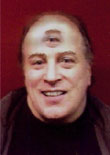|
|
This topic comprises 2 pages: 1 2
|
|
Author
|
Topic: Dangers of Thorium in Carbon Arc gear?
|
|
|
|
|
|
|
|
|
|
|
Stephen Furley
Film God

Posts: 3059
From: Coulsdon, Croydon, England
Registered: May 2002
|
 posted 05-04-2005 01:20 PM
posted 05-04-2005 01:20 PM




Morgan used to make carbons for various purposes, and there were several different core types, giving different spectral properties. Low intensity, uncoated types, used in things like sun lamps and printing down frames used to have coloured paint on the end of them to identify the core type, but I've not seen this on projector carbons. I've certainly seen ones which used cerium salts in the core, but I can't remember whether they were projection ones, or for some other purpose.
I've got a box of strange carbons somewhere; they're Morgan LCT (Low Colour Temperature?) They give a light which seems to be somewhere between a tungsten lamp, and a SON (high pressure sudium). They're difficult to strike, difficult to keep the arc stable, and produce much worse fumes than the normal ones.
I saw 'The Great Dictator' at the Loew's Jersey on Sunday afternoon; I wonder if this will be the last film that I'll ever see, at a public cinema, projected by carbon arc. I think it's quite likely.
How many people here are still burning carbons, and do you have plans to convert?
| IP: Logged
|
|
|
|
|
|
Scott Norwood
Film God

Posts: 8146
From: Boston, MA. USA (1774.21 miles northeast of Dallas)
Registered: Jun 99
|
 posted 05-05-2005 07:33 AM
posted 05-05-2005 07:33 AM





I can think of a few places that still run carbon. I have been known to work at the Avon Cinema in Providence, RI from time to time. They are still running 8mm and 7mm carbons in Enarc lamphouses on a daily basis.
In the past, I have worked at the Cape Cinema (Dennis, MA.), which is open seasonally. I am told that they still run carbon (6mm and 7mm in Peerless lamps).
Other carbon houses that I can think of offhand: IOKA (Portsmouth, NH), Cinestudio (Hartford, CT.), Wellfleet DI (Wellfleet, MA.), and maybe a few others.
There are other uses for carbon arc lighting besides film projection, too. I recently had an interesting conversation with someone who was operating a WWII-vintage searchlight, which burned very thick carbons (non copper-coated) and is one of the brightest man-made light sources available. They were originally built for detecting enemy aircraft (in the pre-RADAR days), and are now used for advertising car dealerships and movie premieres. Carbons are also used in older followspots and I believe that they also have some application in offset printing (exposing plates, I think). Arc lamps (Mole Brute Arcs) are sometimes used in film prodution as well.
Possible health risks aside, I love the look of carbon arc light and I think that there is something worthwhile about keeping alive the earliest practical form of electric illumination.
| IP: Logged
|
|
Stephen Furley
Film God

Posts: 3059
From: Coulsdon, Croydon, England
Registered: May 2002
|
 posted 05-05-2005 08:36 AM
posted 05-05-2005 08:36 AM




quote: Scott Norwood
I can think of a few places that still run carbon. I have been known to work at the Avon Cinema in Providence, RI from time to time. They are still running 8mm and 7mm carbons in Enarc lamphouses on a daily basis.
In the past, I have worked at the Cape Cinema (Dennis, MA.), which is open seasonally. I am told that they still run carbon (6mm and 7mm in Peerless lamps).
Other carbon houses that I can think of offhand: IOKA (Portsmouth, NH), Cinestudio (Hartford, CT.), Wellfleet DI (Wellfleet, MA.), and maybe a few others.
I think there's only one left in Britain now, and I've never been there; it's the other end of the Country. The last I heard, The Dome, Worthing, still had one of their old projectors, and could still runn the odd reel on it.
quote: Scott Norwood
There are other uses for carbon arc lighting besides film projection, too. I recently had an interesting conversation with someone who was operating a WWII-vintage searchlight, which burned very thick carbons (non copper-coated) and is one of the brightest man-made light sources available. They were originally built for detecting enemy aircraft (in the pre-RADAR days), and are now used for advertising car dealerships and movie premieres.
You should see the price of those carbons now!
quote: Scott Norwood
Carbons are also used in older followspots and I believe that they also have some application in offset printing (exposing plates, I think). Arc lamps (Mole Brute Arcs) are sometimes used in film prodution as well.
The last place I saw running carbon spots here was about six or seven years ago. The London Palladium still had them not so very long ago, but I suspect that they've gone now. Very few, if any platemakers are still using them now, though it's not that many years ago that they were still quite common.
The last brutes I saw being used on location were at London's St. Pancras Station, quite a few years ago now; I don't know what the production was. Everything seems to be HMIs now.
They were also used in sun (health)lamps, and 'fadeometers', and an arc struck between a carbon electrode and the specemin was used in spectrometers.
Also used in the lab for producing BuckminsterFullerine (C60).
I'll be sad to see the last one go, but I don't think it can be long now. I would guess maybe 2-5 years until the last cinema converts, or closes.
| IP: Logged
|
|
|
|
|
|
|
|
|
|
|
|
|
|
All times are Central (GMT -6:00)
|
This topic comprises 2 pages: 1 2
|
Powered by Infopop Corporation
UBB.classicTM
6.3.1.2
The Film-Tech Forums are designed for various members related to the cinema industry to express their opinions, viewpoints and testimonials on various products, services and events based upon speculation, personal knowledge and factual information through use, therefore all views represented here allow no liability upon the publishers of this web site and the owners of said views assume no liability for any ill will resulting from these postings. The posts made here are for educational as well as entertainment purposes and as such anyone viewing this portion of the website must accept these views as statements of the author of that opinion
and agrees to release the authors from any and all liability.
|

 Home
Home
 Products
Products
 Store
Store
 Forum
Forum
 Warehouse
Warehouse
 Contact Us
Contact Us




 Printer-friendly view of this topic
Printer-friendly view of this topic






![[uhoh]](graemlins/uhoh.gif)
![[Eek!]](eek.gif)









![[Razz]](tongue.gif)




